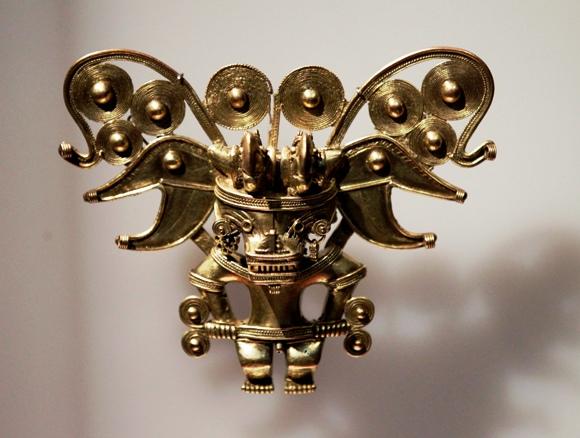
The global financial crisis added to gold’s allure, owing initially to fear of a second Great Depression, notes Kenneth Rogoff
In principle, holding gold is a form of insurance against war, financial Armageddon, and wholesale currency debasement.
And, from the onset of the global financial crisis, the price of gold has often been portrayed as a barometer of global economic insecurity.
So, does the collapse in gold prices -- from a peak of $1,900 per ounce in August 2011 to under $1,250 at the beginning of July 2013 -- represent a vote of confidence in the global economy?
To say that the gold market displays all of the classic features of a bubble gone bust is to oversimplify.
There is no doubt that gold’s heady rise to the peak, from around $350 per ounce in July 2003, had investors drooling.
The price would rise today because everyone had become convinced that it would rise even further tomorrow.
. . .

Doctors and dentists started selling stocks and buying gold coins.
Demand for gold jewellery in India and China soared.
Emerging market central banks diversified out of dollars and into gold.
The case for buying gold had several strong components.
Ten years ago, gold was selling at well below its long-term inflation-adjusted average, and the integration of three billion emerging market citizens into the global economy could only mean a giant long-term boost to demand.
That element of the story, incidentally, remains valid.
The global financial crisis added to gold’s allure, owing initially to fear of a second Great Depression.
. . .

Later, some investors feared that governments would unleash inflation to ease the burden of soaring public debt and address persistent unemployment.
As central banks brought policy interest rates down to zero, no one cared that gold yields no interest.
So it is nonsense to say that the rise in the price of gold was all a bubble.
But it is also true that as the price rose, a growing number of naïve investors sought to buy in.
Lately, of course, the fundamentals have reversed somewhat, and the speculative frenzy has reversed even more.
China’s economy continues to soften; India’s growth rate is down sharply from a few years ago.
. . .

By contrast, despite the ill-advised fiscal sequester, the US economy appears to be healing gradually.
Global interest rates have risen 100 basis points since the US Federal Reserve started suggesting -- quite prematurely, in my view -- that it would wind down its policy of quantitative easing.
With the Fed underscoring its strong anti-inflation bias, it is harder to argue that investors need gold as a hedge against high inflation.
And, as the doctors and dentists who were buying gold coins two years ago now unload them, it is not yet clear where the downward price spiral will stop.
Some are targeting the psychologically compelling $1,000 barrier.
In fact, the case for or against gold has not changed all that much since 2010, when I last wrote about it.
. . .

In October of that year, the price of gold -- the consummate faith-based speculative asset -- was on the way up, having just hit $1,300.
But the real case for holding it, then as now, was never a speculative one.
Rather, gold is a hedge.
If you are a high-net-worth investor, or a sovereign wealth fund, it makes perfect sense to hold a small percentage of your assets in gold as a hedge against extreme events.
Holding gold can also make sense for middle-class and poor households in countries -- for example, China and India -- that significantly limit access to other financial investments.
For most others, gold is just another gamble that one can make.
And, as with all gambles, it is not necessarily a winning one.
. . .

Unless governments firmly set the price of gold, as they did before World War I, the market for it will inevitably be risky and volatile.
In a study published in January, the economists Claude Erb and Campbell Harvey consider several possible models of gold’s fundamental price, and find that gold is at best only loosely tethered to any of them.
Instead, the price of gold often seems to drift far above or far below its fundamental long-term value for extended periods.
(This behaviour is, of course, not unlike that of many other financial assets, such as exchange rates or stock prices, though gold’s price swings may be more extreme.)
Gold bugs sometimes cite isolated historical data that suggest that gold’s long-term value has remained stable over the millennia.
. . .

For example, Stephen Harmston’s oft-cited 1998 study points to anecdotal evidence that an ounce of gold bought 350 loaves of bread in the time of Nebuchadnezzar, king of Babylon, who died in 562 BC.
Ignoring the fact that bread in Babylon was probably healthier than today’s highly refined product, the price of gold today is not so different, equal to perhaps 600 loaves of bread.
Of course, we do not have annual data for Babylonian gold prices.
We can only assume, given wars and other uncertainties, that true market prices back then, like today, were quite volatile.
So the recent collapse of gold prices has not really changed the case for investing in it one way or the other.
Yes, prices could easily fall below $1,000; but, then again, they might rise.
Meanwhile, policy makers should be cautious in interpreting the plunge in gold prices as a vote of confidence in their performance.
The writer is professor of economics and public policy at Harvard University
Copyright: Project Syndicate, 2013